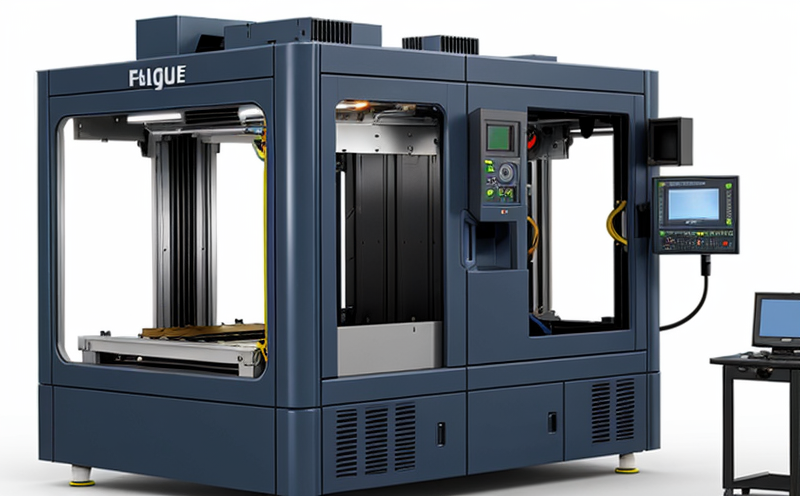ASTM F3122 Fatigue Performance Testing of AM Metal Parts
The ASTM F3122 standard provides a comprehensive framework for fatigue testing of parts produced by additive manufacturing (AM) processes. This standard is crucial in ensuring the reliability and durability of metal components across various industries, including aerospace, automotive, and medical devices.
ASTM F3122 defines procedures to evaluate the fatigue performance of AM metal parts through cyclic loading tests. These tests are designed to simulate real-world conditions that a component might encounter during its operational lifecycle. By subjecting specimens to controlled cycles of stress, engineers can identify potential weaknesses and ensure compliance with design specifications.
The ASTM F3122 standard emphasizes the importance of accurate specimen preparation, which is critical for obtaining reliable results. Specimens are typically prepared by slicing or cutting from larger printed parts using precision tools. This ensures that the test samples accurately represent the intended component geometry and material properties.
Instrumentation plays a vital role in ASTM F3122 testing. High-precision machines, such as universal testing machines (UTMs) equipped with strain gages, are used to apply cyclic loading to the specimens. These machines provide real-time data on stress and strain, which are essential for evaluating fatigue behavior. Additionally, specialized software tools help analyze the collected data, providing insights into the component's fatigue life.
The acceptance criteria outlined in ASTM F3122 are stringent, ensuring that only parts meeting these standards can be considered safe for use. The standard specifies limits on allowable stress and strain values, as well as guidelines for interpreting test results. Compliance with these criteria is essential to ensure the reliability of AM metal components.
The ASTM F3122 standard also addresses the challenges associated with testing AM parts, such as ensuring consistency in material properties across different layers. This is particularly important because additive manufacturing can introduce variations that traditional machining processes do not. By addressing these challenges, ASTM F3122 helps maintain quality and reliability in AM metal components.
Compliance with ASTM F3122 is mandatory for manufacturers seeking to ensure the safety and performance of their AM metal parts. It provides a clear roadmap for testing procedures, specimen preparation, instrumentation, and data analysis. This standard not only enhances product reliability but also fosters innovation by enabling manufacturers to push the boundaries of AM technology.
In conclusion, ASTM F3122 fatigue performance testing is essential for ensuring the durability and safety of additive manufactured metal parts. By following this standard, manufacturers can achieve reliable test results that comply with industry best practices and regulatory requirements.
Benefits
- Enhanced Reliability: Ensures that AM metal parts meet the required durability standards.
- Informed Decision-Making: Provides critical data for design optimization and process improvement.
- Regulatory Compliance: Meets industry standards, ensuring compliance with regulatory requirements.
- Improved Quality Control: Identifies potential issues early in the production cycle to prevent costly rework or failures.
The ASTM F3122 standard offers numerous benefits for manufacturers and quality assurance teams. By following this rigorous testing procedure, companies can ensure that their AM metal parts meet industry standards and deliver reliable performance over extended lifecycles.
Environmental and Sustainability Contributions
- Sustainable Materials: Promotes the use of sustainable materials in additive manufacturing processes.
- Reduced Waste: Minimizes material waste by optimizing design and production processes.
- Eco-Friendly Processes: Encourages the adoption of environmentally friendly AM technologies that reduce energy consumption.
The ASTM F3122 standard also contributes to environmental sustainability. By promoting the use of sustainable materials and minimizing waste, this testing procedure supports a more eco-friendly approach to manufacturing. Additionally, it encourages the development of processes that are less resource-intensive, thereby reducing the overall carbon footprint of AM metal parts.
Use Cases and Application Examples
The ASTM F3122 standard finds application in numerous industries where reliability and performance are critical. In aerospace, for instance, it ensures that parts used in aircraft structures can withstand the extreme stresses encountered during flight. Similarly, in automotive applications, the standard guarantees that engine components can endure high loads without failure.
In medical devices, ASTM F3122 testing is essential to ensure that implants and prosthetics are safe and durable for long-term use. The standard's emphasis on fatigue performance helps prevent premature failures that could compromise patient safety.
For manufacturers of consumer electronics, the ASTM F3122 standard ensures that components can withstand repeated stress cycles without damage, thus enhancing product longevity and reliability.
The versatility of ASTM F3122 extends to various sectors, making it a valuable tool for quality assurance teams across industries. By adhering to this standard, manufacturers can ensure that their AM metal parts meet the highest industry standards, thereby gaining a competitive edge in the market.





